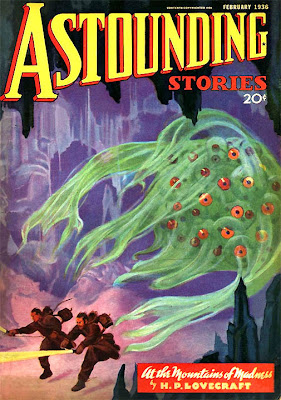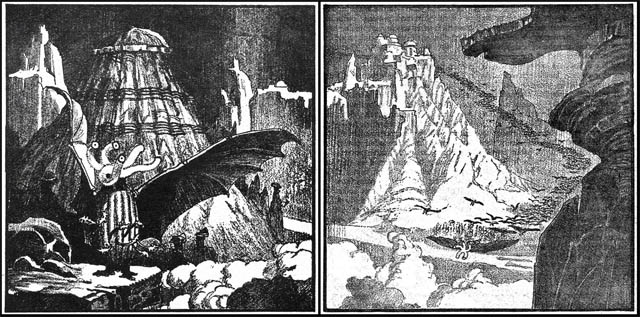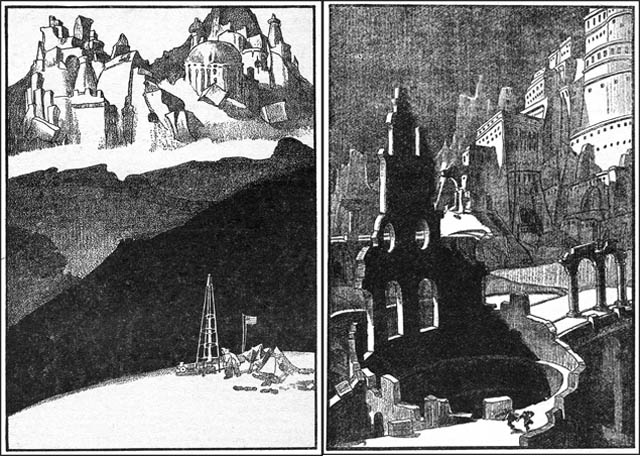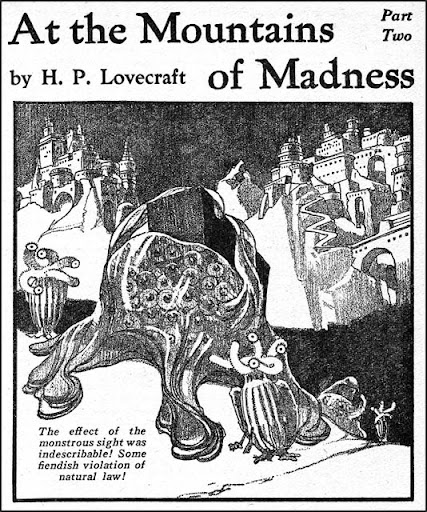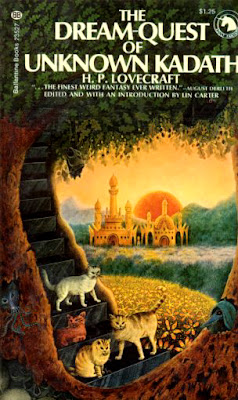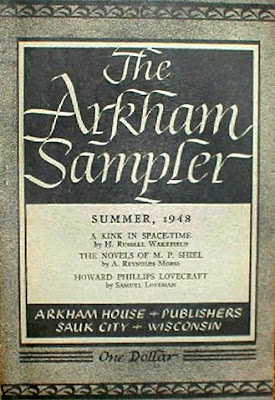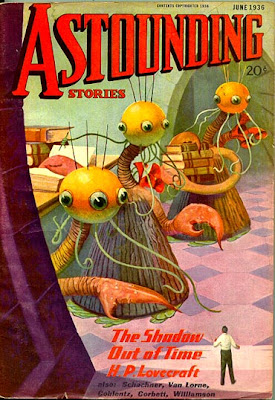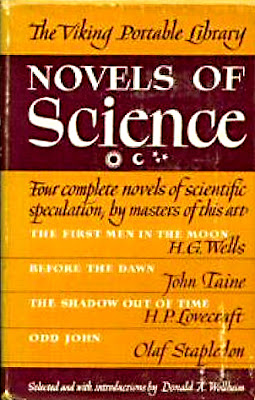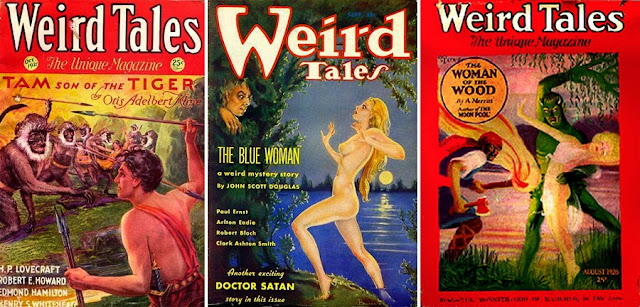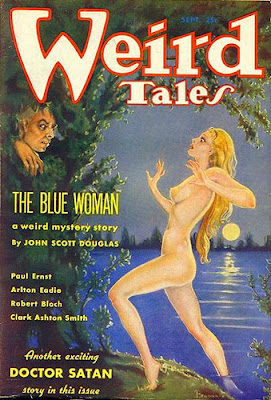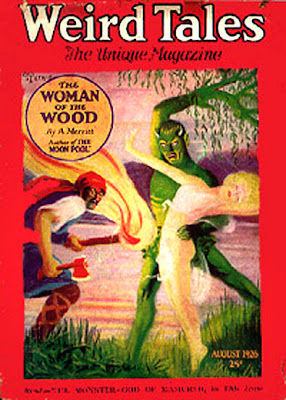Science Fiction and Fantasy Reading Experience: H. P. Lovecraft (original) (raw)
H. P. Lovecraft
"At the Mountains of Madness" (nv)
(Cthulhu Mythos)
© 1931, original
Astounding Stories, Feb 1936
novel: 1939, Gollancz
--/ third place sf novel
--/ wonder award
--/ adventure award
--/ style award
--/ emotion award
--/ shock value
Review by author M. Christian
Talking about an H. P. Lovecraft book is -- to paraphrase that old chestnut -- like singing about food, or writing about music. What makes it doubly difficult is that so many others have tried: Lovecraft’s probably been analyzed and dissected more than any other fantasy author. So much so that a comprehensive review has also to mention every other review, and so on and so forth ad infinitum.
But putting aside the difficulty of a review, and every other review, At the Mountains of Madness is still a brilliantly told horror story. Best of all, it’s almost a "perfect" Lovecraft story, combining everything that makes Lovecraft … well, ‘Lovecraftian:’ constant impending dread, mysteries beyond time and space, characters driven to the brink of -- and then beyond -- insanity, science knocking at the doors of the nightmarish unknown, and tantalizing clues to a star-and-time-spanning mythology.
Told by William Dyer, of Lovecraft’s ubiquitous Miskatonic U (“Go Pods!”), At the Mountains of Madness is about an expedition to Antarctica, which, in 1936, might as well have been the dark side of the moon. While there, Dyer and the other members of the expedition encounter various dreads and haunting mysteries (this is Lovecraft after all: specifics isn’t what he’s all about) until they discover an ancient city and with it, the horrifying secret of the Elder Things, the once-great-but-now-extinct terrifying rulers of time and space.
For a book written more than 70 years ago, At the Mountains of Madness still has a dreadful power. Like the tomes so often mentioned by Lovecraft, the novel crawls under the skin before twisting around the knots of the spine before working its way to the brain and then straight into the mind. Hallucinatory and haunting, the book reads more like a narrative nightmare than what most people think of when they think of a novel.
What’s particularly interesting about At the Mountains of Madness is how it forms a ‘bridge’ between Lovecraft’s mythology. Before it, his "horrors from beyond" were more mythological, but with At the Mountains of Madness he instead moves in a more science fictionlike direction -- a change many other reviewers have called extremely significant for his very long-lasting popularity.
Dream, nightmare, hallucination -- Lovecraft and especially At the Mountains of Madness might be hard to pin down, hard to quantify, but the work, and especially its author, remain truly great legends of horror, and not to be missed … if you want to lose sleep.
----------------------------------------------
H. P. Lovecraft "The Dream-Quest of Unknown Kadath" (nv)
©> 1926, original
Arkham Sampler, 1948
Beyond The Wall Of Sleep, 1943
At The Mountains Of Madness, 1968
--/ FIRST place f novella
--/ wonder award
--/ adventure award
--/ style award
--/ emotion award
--/ awesome scale
Review by A. Abrams
Reading this novella was a peculiar experience - a dream, or rather a trance, with sights floating by, wonder upon wonder, written in the very ornate, intensely descriptive prose; a narrative that - if you let it - will pull you in and leave you stranded inside that same dream. Which is exactly what happened to me. Can you believe it, I've never been able to finish reading it... Somewhere half-way along the quest the sheer weird beauty and the implied deep horror of thousands of wonders reached a critical mass in my head and prevented me from going further, prompting rather to stop, savour at length and reflect on what I've already read. So I do not even know how it ends. Maybe one day I will try this book again, armed with a more jaded and indifferent approach, and will escape this bizarre dream-like effect, but for now - nothing I have ever read (not even Tolkien) produced such vivid images of strange worlds in my head.
Admittedly, I did not read Lord Dunsany stories (upon which Lovecraft modelled this novel), but then you can only have so much of that kind of "high imaginative calorie" food. It has a minimal plot, and fulfills exactly the promise of the title: it's "a Dream Quest in a Mysterious and Haunted Land" with elements of dark and high fantasy intermingled. A painting, perhaps? A symphony? Any of these things, but not a novel per se, rather a haunting poetry.
----------------------------------------------
H. P. Lovecraft
"The Shadow Out Of Time"
(Cthulhu Mythos series)
© Astounding Stories, Jun 1936
The Dunwich Horror, 1963
--/ fourth place sf novella
--/ wonder award
--/ awesome scale
In this particular case Lovecraft's attempt at science fiction ultimately disappoints. I approached this novella with a great expectation to find something of a magnitude of "The Mountains of Madness", but the pedantic and non-involving style of the narrative, combined with not enough tension and visuals, spoiled it for me. It is, however, a grand effort.
Here is a synopsis from Wikipedia: "It indirectly tells of the Great Race of Yith, an extraterrestrial species with the ability to travel through space and time. They switch bodies with hosts from the intended space or time destination.The Yithians original purpose is to study the history of various times and places, and they have amassed a "library city" that is filled with the past and future history of multiple races, including humans. Ultimately the Yithians use their ability to escape the destruction of their planet in another galaxy by switching bodies with a race of cone-shaped beings who lived 250 million years ago on Earth. The cone-shaped entities (now also known as the Great Race of Yith) live in a vast city in what would later become Australia Great Desert."
Read the full review of this issue of "Astounding" ->
Are these men hallucinating? Do they need drug addiction treatment? Or is something Truly Monstrous in pursuit?
----------------------------------------------
H. P. Lovecraft "The Strange High House In The Mist"
© written in 1926
Weird Tales, Oct 1931
Dagon & Others, 1965
--/ fourth place fantasy story
This is the mother of all "haunted house on a seashore" tales. Just try this short quote for size:
"And when tales fly thick in the grottoes of tritons, and conches in seaweed cities blow wild tunes learned from the Elder Ones, then great eager vapours flock to heaven laden with lore; and Kingsport, nestling uneasy on its lesser cliffs below that awesome hanging sentinel of rock, sees oceanward only a mystic whiteness, as if the cliff's rim were the rim of all earth, and the solemn bells of the buoys tolled free in the aether of faery".
As you can see, the wonder and mystery in this story are not confined to a singular "strange house" alone. In a most insidious way Lovecraftian tales will stay with you for hours, infusing your reality with a faery glow, and (in an even bigger measure) enhancing the shadows, till they grow to be sentient and grimly intent, bound to coalesce around you, if you do not swiftly flee into reality.
----------------------------------------------
BONUS:
In the same year, in 1926 (more than eighty years ago... time not just flies, it seems to have boarded Han Solo's Millenium Falcon and winked out of existence into entirely different continuum) - another writer was starting his career and appearing alongside Lovecraft in the "Weird Tales" magazine. The Grand Master of Space Adventure, Edmon Hamilton made an impression with the very first story he wrote, and here is why:
----------------------------------------------
Edmond Hamilton "The Monster-God of Mamurth"
© Weird Tales, Aug 1926
Weird Tales, Sep 1935
Horror on the Asteroid, 1936
Magazine of Horror, Win 1967
--/ fourth place sf story
--/ wonder award
--/ adventure award
--/ rare find
Review by A. Abrams
Not "science fiction" per se, this was Edmond Hamilton's first published story, and it already has color and excitement aplenty. It is somber, exotic, "Clark-Ashton-Smith"-esque, baroque and morbid in a most delicious ways. Desert landscapes with unspeakable monsters hiding in grandiose mysterious structures, a dread and a trembling for an amateur adventurer and a professional curiosity for Sean Connery-like types. I thoroughly enjoyed this piece, and - just think - it's only the beginning of a Universe-spanning career!
----------------------------------------------
Labels: Features
